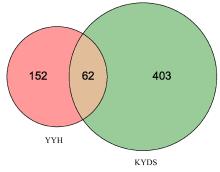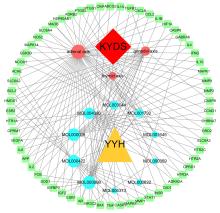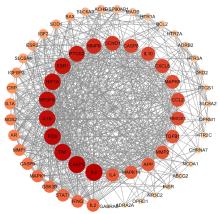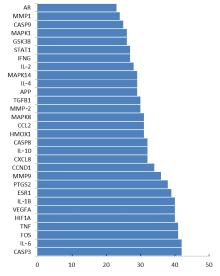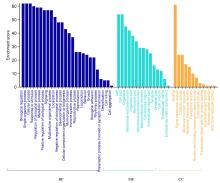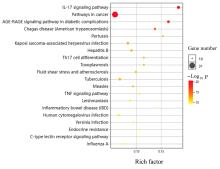吉林大学学报(医学版) ›› 2023, Vol. 49 ›› Issue (5): 1296-1303.doi: 10.13481/j.1671-587X.20230524
• 临床研究 • 上一篇
基于淫羊藿治疗下丘脑-垂体-肾上腺/性腺/甲状腺轴功能损伤药物有效化学成分及其作用靶点的网络药理学与分子对接技术分析
- 吉林大学药学院药学系,吉林 长春 130021
Analysis on network pharmacology and molecular docking technique based on effective chemical components and action targets of epimedium in treatment of hypothalamus-pituitary- adrenal gland/ gonad / thyroid gland axis function damage
Chunling WANG,Sinuo WU,Xiaoyan YU( ),Weidong ZHANG(
),Weidong ZHANG( )
)
- Department of Pharmaceutical Sciences,School of Pharmacy,Jilin University,Changchun 130021,China
摘要:
目的 采用网络药理学方法联合分子对接技术分析淫羊藿治疗下丘脑-垂体-肾上腺/性腺/甲状腺轴功能损伤药物有效化学成分及其作用靶点,并初步阐明其作用机制。 方法 采用中药系统药理学(TCMSP)数据库和分析平台结合相关文献资料获取淫羊藿的有效化学成分及其对应的靶点蛋白,采用Uniprot数据库将靶点蛋白信息标准化得到对应的标准基因名,检索GeneCards 数据库和DisGeNET数据库收集下丘脑-垂体-肾上腺/性腺/甲状腺轴功能损伤的相关靶点基因,采用Cytoscape 3.7.1软件绘制淫羊藿有效化学成分和疾病作用靶点关系的网络图,采用STRING数据库绘制药物与疾病的交集靶点的蛋白-蛋白相互作用(PPI)网络图,采用基迪奥生物信息平台(OmicShare)进行基因本体(GO)功能富集分析和京都基因与基因组百科全书(KEGG)信号通路富集分析,采用Pymol软件和Autodock Tools软件进行淫羊藿药材有效化学成分与下丘脑-垂体-肾上腺/性腺/甲状腺轴功能损伤靶点蛋白的分子模拟对接和可视化。 结果 筛选得到27个淫羊藿有效化学成分和217个相对应作用靶点,下丘脑-垂体-肾上腺/性腺/甲状腺轴功能损伤靶点基因465个,其中62个靶点基因与淫羊藿治疗下丘脑-垂体-肾上腺/性腺/甲状腺轴功能损伤有密切关联。得到淫羊藿关键有效成分为槲皮素、木樨草素、山柰酚和淫羊藿苷等,关键靶点蛋白为含半胱氨酸的半胱氨酸蛋白酶3(Caspase-3)、白细胞介素6(IL-6)、低聚糖(FOS)、肿瘤坏死因子(TNF)、低氧诱导因子1α(HIF1A)、血管内皮生长因子A(VEGFA)、白细胞介素1B(IL-1β)、雌激素受体1(ESR1)、前列腺素内过氧化物合酶2(PTGS2)和基质金属蛋白酶9(MMP-9)等。KEGG信号通路富集分析,其共同靶点主要富集于免疫炎症、激素调节和能量代谢等相关通路上。分子对接,淫羊藿中的潜在有效成分与IL-6、PTGS2、醛糖还原酶(AR)和促分裂原活化蛋白激酶1(MAPK1)等靶点蛋白有较好的亲和作用。 结论 淫羊藿可通过多靶点和多通路在抗炎免疫、激素调节及能量代谢等方面对下丘脑-垂体-肾上腺/性腺/甲状腺轴功能损伤发挥潜在的治疗作用。
中图分类号:
- R966
